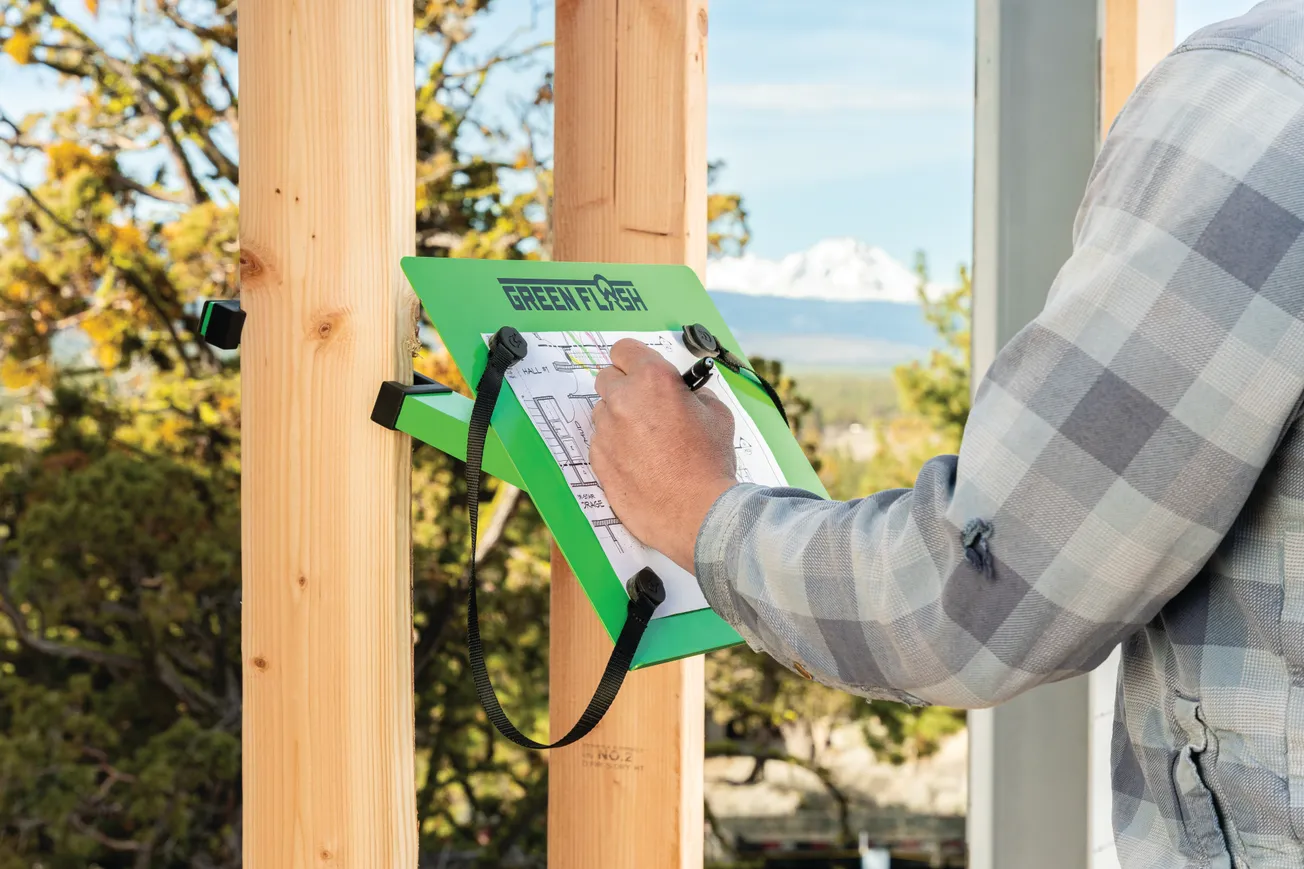Table of Contents
The days of plain white vinyl railings on every deck have given way to a rainbow of railing colors, enabled by the latest manufacturing technologies and the expanding imaginations of designers. With now near-unlimited options, how can builders help guide customers to the best color choice for their deck railing project?
“Choosing the right railing defines your home, and selecting the right color is as important on the outside of the home as it is on the inside,” says Andrew Pantelides, VP of marketing and business development for Regal ideas. “When it comes to doors, trim, shutters and furniture, the color trends we are seeing are ones of eye-catching colors that define personality and style. More and more homeowners are viewing their outdoor spaces as an extension of their indoors.”
Certainly, railing color choice is a critical decision in planning a project. When you walk out onto a deck, your eyes are usually going to see the railing first.
According to Steven Phillips, product manager in charge of railing for Trex, “Our focus is on making sure consumers have safe but inspiring choices that complement any decking color. Earth tones like Vintage Lantern (a chocolate brown) compliment safer choices like Classic White and Charcoal Black. Softer tones like Rope Swing and Gravel Path give consumers more outside-the-box options that aren’t too polarizing. However, making sure the channel can support inventory requirements is always critical, so the color palette has to be selected carefully.”
Fairway’s aluminum systems come in three different colors, steel railings in two, and cellular PVC in white. “Those three railing technologies—aluminum, steel and cellular PVC—cover three color categories in black, bronze and white, which represent about 90% of market demand,” said Chase Moritz, marketing manager for parent Envision Decking. “Within those technologies, we offer varying finish options as well. Textured colors are some of our fastest growing products.”
SpecRail has been tweaking its color options based on customer feedback. Standard colors for its aluminum railings are black, white and bronze. The company used to offer green and sandstone as standard, but they were discontinued due to lack of demand. “Black is the prominent color for both our railing and fence products by far,” shared Joseph Moriarty, new business development manager. “Depending on certain regions of the country, white is preferable. Bronze is still popular and a viable preference for many projects.”
SpecRail also offers custom colors, usually “one-offs” to meet the requirements of certain jobs. Recently, custom red has been popular. “Customers provide a (RAD) color code,” Moriarty said. “These situations require a specific supplier quote on coating material and our set-up/process time based on project volume.”
Making the Choice
Before choosing a railing color, dealers should understand the customer’s style and home architecture including materials used like wood or composite, and how they use their outdoor area. RailFX’s Brenda Collons says, “This will likely drive a customers’ selection of railing style—do they want the railing to blend in, making a lake or mountain view the hero, or stand out as a design feature? And will the outdoor area be used for entertainment, family (including children, pets and older adults), games or pool use? Once the style has been chosen, colors can complement the decision. Colors evoke moods, which drives the preference of stock versus custom colors for the final design.”
Vista Railing Systems’ Erik Flick agrees: “Building color, geographic environment, and personal preference all go into the color selection process. As an example, Gloss White tends to be very popular in coastal areas as a general rule. More urban environments might tend to have color schemes where a Gloss Black is more of a fit. Textured finishes such as Textured Black are certainly rising in popularity as well based upon changing color schemes and the fact that they are easier to keep clean in some cases than the gloss colors.”
To simplify the railing selection process, Trex’s Phillips suggests using one of what Trex calls the “three Cs” to achieve a successful decking and railing pairing:
• Coordinate. You can never go wrong by selecting railing in the same shade as your decking—i.e., dark brown railing for a dark brown deck, or light gray railing to complement light gray boards. This creates a cozy, well-coordinated look and is a great approach for risk-averse homeowners.
• Contrast. If you have trouble finding a perfect match for the decking—or if your customer is open to trying something different—consider a contrasting railing color, such as black or white. Both are classic options that complement virtually any outdoor setting. Classic white looks crisp against deep brown deck boards and is ideal for highlighting a deck’s design and features. Alternately, if you’re working with lighter colored decking, a contrasted look can be achieved by selecting darker railing.
Dark colors give a deck a modern look and feel. They also are a good choice for clients looking to showcase their home’s natural surroundings since dark railings tend to visually blend into the background.
• Customize. For design-savvy homeowners looking for the distinctive, go for a completely customized look. Don’t be afraid to mix colors and materials, such as combining dark aluminum railing and balusters with white composite posts, to create a dramatic look that delivers a sophisticated mixture of texture and color. Other tips:
• To optimize a great view, thin balusters finished in black are a good choice as they tend to optically blend into the environment, putting more visual emphasis on the natural surroundings. Save thicker, tightly spaced balusters for a not-so-appealing view or to deter nosy neighbors.
• Rails should naturally blend with the environment. This brings the feeling of being closer to nature. So not only consider how the railings play off of the deck and home, but also how they look facing away, into nature. Railings should define a space naturally vs. becoming an obtrusive barrier.
• Dark colors, like black and bronze, tend to blend in with a structure from afar, while white and lighter colors will stand out in contrast to the home.
• Colors with more gloss retention typically have less UV breakdown (fading) than matte finish colors.
• Gloss finishes reflect more sunlight, so in a very sunny area, a textured finish on aluminum is often a better choice
• Check on the finish. How does it look and feel? Does it leave fingerprints, or stain? A textured finish affects both look and feel. According to Regal ideas’ Pantelides, “Our textured finish provides a depth of richness to the paint as the light shines on it.”
• Rarely do you see high-end railing materials that are glossy and shiny. Trex’s aluminum and composite railings feature matte finishes that add a rich look to an overall project.
Pick a Color, Any Color
Atlantis Rail offers two cable railing systems with different color options—the NOVA II aluminum cable railing system in white, black and bronze, and the Spectrum System stainless steel cable railing system with stainless steel square posts powder-coated black, pure white, metallic silver, dark brown, light brown, or pebble gray.
In recent years, Atlantis Rail has started to offer color options due to customer demand. “For a long time we only offered a brushed or polished stainless steel finish,” said marketing manager Carey Hicks. “We are offering much lower maintenance options for adding color to railing systems versus painted wood. The color options that we offer are neutral and blend nicely with many different designs and environments.
“It is definitely a customer preference as to which color they choose, but we have noticed that with exterior color palettes expanding, including window trims, customers are looking to match their railing to their trim. Also, color selection depends on the style that the customer wants to showcase. If the railing is on the ocean, some customers opt for a white cable railing system to give a nautical feel. If the railing was going on a residence in the mountains or woods, the customer may opt for a black or dark brown railing system so as to blend with nature and not interfere with the environment.”
The proliferation of literally hundreds of different deck railing colors is primarily attribute to advances in powder-coating. Duradek’s aluminum railings come in 12 standard and over 180 custom colors. “The ability to provide custom colors in railing and fencing products is important to ensure a good match to a home’s window coverings or window sidings,” notes Blair Holiday, Durarail sales manager. “The most important thing is using a super durable powder for the finish.”
Digger Specialties, Inc. offers 12 standard AAMA 2604 colors for its Westbury aluminum railing, ADA Handrail, and B Series balusters in its PolyRail vinyl railing line, chosen specifically to play off homeowners’ decks, homes, gardens and yards.
“We believe your outdoor living space should match your style and color palette,” explains marketing manager Mary Gearhart. “Every year the decking industry adds colors to their decking options, paint companies add colors to their exterior home colors, and vinyl siding companies add new color options to their color offerings. We have a standard color that can accent the colors in your outdoor living space. But you don’t have to stop there—DSI offers a custom color program for all our aluminum products. You provide a color sample, we match it to an AAMA color.”
Ultimately, the most important factor is what looks good to the client. “It really is a matter of personal preference and aesthetics,” said Jeremiah Hershberger, product manager for Superior Plastics, which provides vinyl railing in three colors and aluminum in four. “We offer so many colors because people like to have options for a customized railing, but all of our aluminum and vinyl colors are powder-coated or manufactured to last, so it really doesn’t matter from a functional perspective.”










